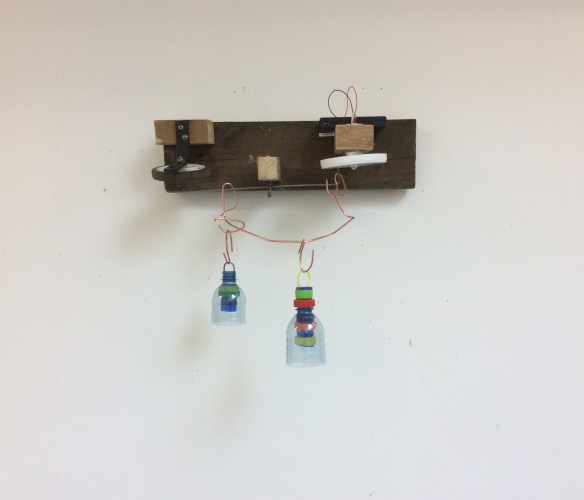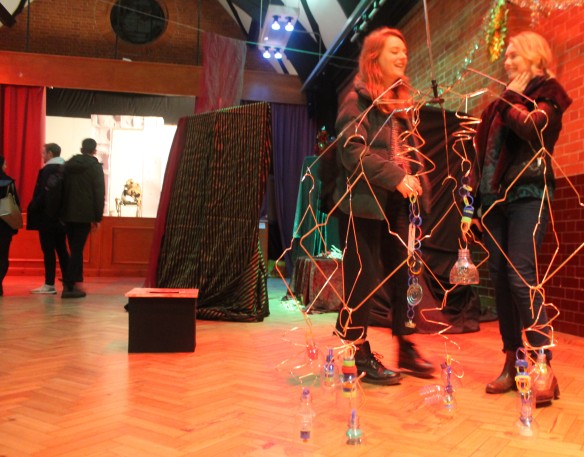My installation is a suspended mobile. Hung from the support beams by chains it generates a crude aesthetic. It is constructed from wood, metal rods, wire hangers, copper pipes and chains. The wire hangers have been cut and shaped by pliers; the process has worn and grazed them. Two metal rods, linked by a modified wire hanger, act as a mechanism to move the 3 copper pipes descending from it. Each copper pipe faces a different direction and are attached to one another by pieces of wire hanger. It is intended to be interacted with. When both rods are turned in unison, the copper pipes gently rise and fall. When only one rod is turned, the copper pipes swing violently.
The work can function as a sculpture to be observed or interacted with. This opens up a contingency whereby the viewer chooses what form the piece takes, limiting the control I have. The possibility of interaction toys with the notion that through the emergence of the virtual world, we have become distanced from materiality.
My work over the last year has involved looking at the formless; creating large, bulky structures constructed out of papier mâché and chicken wire. More recently I have looked at the loss and gain of form, questioning at which point does something become formless. Following an exhibition in the autumn term where I presented a mobile constructed out of repurposed found objects, I became particularly interested in kinetic art. When the mobile moved the reflections and shadows on the floor moved as well, creating new forms. This led me to creating a battery-operated mobile propelled by a motor. Developing from this concept of motion, I decided to add the the option of interaction.
My decision to begin creating mobiles was inspired by Alexander Calder (1898-1976), whose mobiles were concerned with chance in their aesthetic and were either powered by air movement or by motors. The crude aesthetic of the mobile was heavily influenced by Jean Tinguely (1925-1991) who created sculptural machines criticising the advancing robotic production stemming from the industrial revolution.
Category Archives: Assessment 18/19
Adding interactive element
Jean Tinguely’s metamechanical sculptures address robotic production of material goods arising from industrialisation. As a continuation of this idea, the increasing technological advances and emerging virtual world has distanced us from materiality. For example, through the use of social media or VR technology. Hence, I chose to add the component of interaction to address this shift.
Exhibition 3- Spring Term Exhibition
This mobile generates the aforementioned crude aesthetic. It incorporates some elements of the first mobile. It requires the viewer to turn on the switch to make the motor move, echoing features of Jean Tinguely’s work.
Jean Tinguely (1925-1991)
Jean Tinguely was born in Fribourg, Switzerland. Around late 1930s, he started making hanging sculptures, using found objects, that had motors to propel them into motion. He later termed his mechanical sculptures “Méta-Malevich.” These works are now known as “Méta-mécaniques” (meaning meta-mechanical), which was how Pontus Hultén referred to them in 1954. His work mixes junk sculpture with kinetics. Often in his work, the viewer had to push a button or pull a lever to make them move. The works relate to his belief in destabilizing the “utilitarian purpose of the machine.”
This work has influenced my selection of crude, worn found objects to work with to create a mechanical mobile.

Jean Tinguely, “Metamechanical Sculpture with Tripod”, 1954
Continuing creating mobiles
I intended to create more mobiles (influenced by Alexander Calder). I wanted to move away from the static mobiles moved by air flow, and introduce a motorised/mechanical element. Below is the rudimentary design of the mechanised element of the mobile.

VIVA Presentation
Exhibition 2 (week 11)
The artworks I have produced concern the loss and gain of form, exploring the question “When does something become nothing?” These artworks challenge the viewers perception. More recently, this includes amalgamating ready-made objects to determine whether we can, momentarily, overlook what they are individually, and view them as something new. These artworks include both mixed media pieces and sculpture.
Suspended from a string that stretches across the room, this piece appears delicate and light, nearing transparency. The only telling sign of its weight is the droop in the string it is suspended from. At first glance, it appears ethereal. However, upon closer inspection, people begin to recognise the different objects that were used to construct the piece. Multiple strands descend from the central umbrella skeleton; comprising of wire hangers, plastic bottles, tin lids, plugs, and buttons. The lighting in the space prompts the emergence of new forms on the floor which move in synchrony with the suspended structure.
My work is informed by “Seeing things as they are: a theory of perception” (Searle, 2015), Alexander Calder and Iza Tarasewicz. Searle discusses current theories of perception and offers up a new theory. Calder created mobiles which shift with the movement of air, reinventing the space around them. Tarasewicz gives found objects a new life by integrating them together into one art piece. Text about Tarasewicz’s work displayed at Croy Nielsen from a press release has also influenced my work; “loose arrangements that together create a larger system, an organism that is more than the sum of its parts.” The combinations of components from the objects become more integral to the piece than the objects themselves, which is something that resonated with me in my practice.

The Technicolour Dreamboats, December 2018
Alexander Calder
Alexander Calder (1898–1976) was an American sculptor, born in Lawnton, Pennsylvania. He made abstract sculptures and began introducing moving parts in 1931-32, these were called “mobiles.” Stationary versions were named “Stabiles.” The mobiles move with the flow of air and “continually redefine the space around them as they move.” My own sculpture acts in the same way as these mobiles due to the umbrella swaying and twisting round with any breeze.

“Mobile”
Iza Tarasewicz
Iza Tarasewicz (1981) was born in Bialystok, Poland and lives and works in both Kolonia Koplany, Poland and Munich, Germany. Her works includes sculpture, installation, object, drawings and performance actions. In the work below, Tarasewicz uses metal pieces to create something alien. We can’t recognise what the metal once looked like. In a quote from Croy Nielsen, they imply that the final installation is “more than the sum of it’s parts.” What I took this to mean, was that the metal pieces become part of something new and are no longer recognised as individual objects.

“In Myriads, things cry out”
Croy Nielsen- “An organism that is more than the sum of it’s parts”
https://croynielsen.com/exhibitions/iza-tarasewicz-in-myriads-things-cry-out/
https://frieze.com/article/iza-tarasewicz-coaxes-found-objects-life
Moving from 2D to 3D
Can ready-made objects lose their form and become unrecognisable?
- Iza Tarasewicz makes sculptures using found materials creating “an organism that is more than the sum of its parts”
(https://croynielsen.com/exhibitions/iza-tarasewicz-in-myriads-things-cry-out/)
My work so far has looked at the loss of form on a 2-dimensional surface using found objects. I intend to continue using found objects but translate it into the 3-dimensional.
Below is some of the bottle components, buttons and copper hangers I have been experimenting with.
Exhibition 1 (week 5)
My current work is a series of mixed media pieces. It incorporates found objects and materials i.e. nails, cardboard, chicken wire, string etc. It explores the loss/gain of form and challenges the viewer to find form. The materials are sewn onto hexagonal, square and circular canvases. Each piece has varying levels of busyness; this is to explore when something loses form because there is too much happening and consequently the viewer becomes overstimulated.
This work is informed by modernist theory/Jackson Pollock, whose revolves around the non-human. I am currently reading “Seeing things as they are: a theory of perception” (Searle, 2015), which discusses current theories of perception and offers up a new theory . The artists Mona Hatoum and Ghada Amer have also influenced my work. Hatoum uses found materials and presents them in such a way that they seem alien, and Amer uses embroidery to create/eliminate form.
My practice circulates around the question “when does something become nothing?” and over the past year has revolved around the formless. This project is a continuation of previous work by looking at when something with form becomes formless. I have been looking at perception, particularly how different people perceive the same artwork, finding distinct forms. This is demonstrated in the illusion “Rubin’s vase”, where individuals perceive either a vase or the profiles of two people. I have also considered how presenting familiar forms in a certain way can make them unrecognisable.

Mixed Media Tryptic, October 2018








